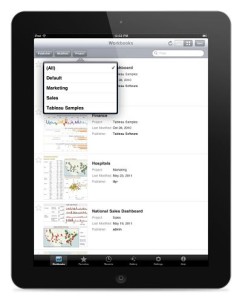Best Practices for Mobile Business Intelligence
 Data analysis has become integrated and rooted in the operations and decision-making of every organisation or, at least, in those with foresight. The same can be said regarding the adaptation of technology to workforce mobility. Tableau, provides some advice on merging both realities:
Data analysis has become integrated and rooted in the operations and decision-making of every organisation or, at least, in those with foresight. The same can be said regarding the adaptation of technology to workforce mobility. Tableau, provides some advice on merging both realities:
1. Avoid dashboard proliferation
Business Intelligence tools should adapt to and not copy desktop versions. This will enable users to avoid the proliferation of dashboards, creating a single version that can adapt to all devices and not one version for each device. In this way, control panels will be the same, except for minor differences between the desktop version and the one being used on a tablet, for example.
To make this possible, we need software like Tableau, capable of detecting different types of devices. However, if the solution requires you to build a new dashboard for each device, you will be unable to enjoy the benefits of having the same one: time saving and fewer headaches regarding maintenance.
2. Create with a smaller form factor in mind
The display size of tablets, although larger than mobile phone screens, are still smaller than what a computer can offer. This difference in size has a great impact on how people use Business Intelligence tools.
It is really a question of space efficiency, which can be overcome with a few recommendations:
- Place the most relevant information in the top left-hand corner. Based on humans’ visual conduct patterns, that is where we start to look at the screen.
- Limit the dashboard to 2 or 4 views. Cluttering the screen with data will only make it more complicated for mobile users.
- Exercise moderation regarding legends and filters.
3. Think like a mobile user
Another big difference between mobile and desktop versions requires understanding that users are constantly on the go. This means that they are going to be less inclined to look for a specific function or some very specific information that is not directly available.
A data analysis tool must take all this into account:
- Allow users to browse: your dashboard should be a first stop that leads to finding more specific data. Make sure your tool can examine different types of data intuitively.
- Provide content search features: having the necessary information is not enough unless you can find it easily from the dashboard. Some organisations have many types of content and, therefore, it must be organised based on date, project, author, name…
In addition, it is advisable to take into account whether users will need some training to use the mobile version: if the implementation process is slow, the benefits will be fewer.
4. Take new mobile scenarios into consideration
Although creating a single dashboard that can be adapted to all devices is highly beneficial, sometimes there are additional benefits in coming up with a specific design for a mobile environment. Regarding Data Management strategies, it is advisable to consider whether current dashboards are good enough or whether they provide the necessary information to interact with the company’s workforce, customers or partners. In order to reach useful conclusions, it is worthwhile to obtain certain information on the people who will be using the tool:
- What is the toughest aspect of their job?
- What information is difficult for them to obtain and when do they need it?
- What is their daily routine and how long does it take them to obtain the information?
- How much information can they obtain?
5. Make the most of the natural mobile collaboration process
Mobile applications have a social element. They are used in meetings, in our offices or at customers’ offices. Take advantage of this with your company’s Business Intelligence applications:
- Provide interactive filters, classification and zoom features so that users can browse data during a meeting.
- Allow comments so that questions and ideas are not lost.
- Ensure that the solution is fast enough so that everyone can follow the pace of the meeting.
- It is very important that your Business Intelligence solution features total data safety and user authentication. Business Intelligence cooperation opportunities should not result in security issues if the safety protocols are correct.
Would you like to know more about this tool? We will be happy to answer any questions you may have and help you implement it in your organisation. Contact Intelligence Partner.
Source: Whitepaper: 5 Best Practices for Mobile Business Intelligence
More information: Tableau Software; data management strategy; What do you want from a Business Intelligence tool?; Contact Intelligence Partner


